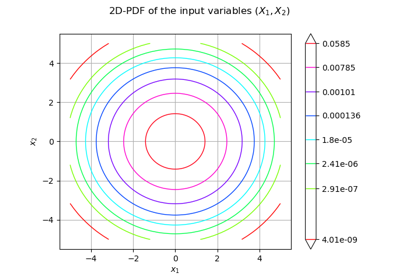MultiFORM¶
- class MultiFORM(*args)¶
FORM approximation with multiple design points.
This algorithm searches for several design points by restarting the nearest-point search. For each design point we add a bulge function that penalizes the limit-state G around it:
The bulge function can be chosed as:
Once these points are found a FORM is computed with each point and the probability of interest is computed as a series system probability: the union of the approximated events:
Beware, as with the regular FORM method the search can fail, or the enumeration of design can be not incomplete.
More details can be found in [kiureghian1998].
- Parameters:
- solver
OptimizationAlgorithm Optimization algorithm used to search the design point.
- event
RandomVector Failure event
- physicalStartingPointsequence of float
Starting point of the optimization algorithm, declared in the physical space.
- solver
See also
Examples
>>> import openturns as ot >>> dim = 2 >>> f = ot.SymbolicFunction(['x0', 'x1'], ['5.0-x1-0.5*(x0-0.1)^2']) >>> dist = ot.Normal(dim) >>> X = ot.RandomVector(dist) >>> Y = ot.CompositeRandomVector(f, X) >>> event = ot.ThresholdEvent(Y, ot.Less(), 0.0) >>> solver = ot.Cobyla() >>> starting_pt = dist.getMean() >>> algo = ot.MultiFORM(solver, event, starting_pt) >>> algo.run() >>> result = algo.getResult() >>> n_design_pts = len(result.getFORMResultCollection()) >>> pf = result.getEventProbability()
Methods
Accessor to the result.
Accessor to the object's name.
getEvent()Accessor to the event of which the probability is calculated.
Accessor to the maximum number of design points.
getName()Accessor to the object's name.
Accessor to the optimization algorithm used to find the design point.
Accessor to the starting point of the optimization algorithm.
Accessor to the result.
hasName()Test if the object is named.
run()Evaluate the failure probability.
setEvent(event)Accessor to the event of which the probability is calculated.
Accessor to the maximum number of design points.
setName(name)Accessor to the object's name.
setNearestPointAlgorithm(solver)Accessor to the optimization algorithm used to find the design point.
setPhysicalStartingPoint(physicalStartingPoint)Accessor to the starting point of the optimization algorithm.
setResult(formResult)Accessor to the result of FORM.
- __init__(*args)¶
- getAnalyticalResult()¶
Accessor to the result.
- Returns:
- result
AnalyticalResult Result structure which contains the results of the optimisation problem.
- result
- getClassName()¶
Accessor to the object’s name.
- Returns:
- class_namestr
The object class name (object.__class__.__name__).
- getEvent()¶
Accessor to the event of which the probability is calculated.
- Returns:
- event
RandomVector Event of which the probability is calculated.
- event
- getMaximumDesignPointsNumber()¶
Accessor to the maximum number of design points.
- Returns:
- max_dpint
Maximum number of design points
- getName()¶
Accessor to the object’s name.
- Returns:
- namestr
The name of the object.
- getNearestPointAlgorithm()¶
Accessor to the optimization algorithm used to find the design point.
- Returns:
- algorithm
OptimizationAlgorithm Optimization algorithm used to research the design point.
- algorithm
- getPhysicalStartingPoint()¶
Accessor to the starting point of the optimization algorithm.
- Returns:
- point
Point Starting point of the optimization algorithm, declared in the physical space.
- point
- getResult()¶
Accessor to the result.
- Returns:
- result
MultiFORMResult Contains the global result as well as the sub FORM results.
- result
- hasName()¶
Test if the object is named.
- Returns:
- hasNamebool
True if the name is not empty.
- run()¶
Evaluate the failure probability.
Notes
Evaluate the failure probability and create a
FORMResult, the structure result which is accessible with the methodgetResult().
- setEvent(event)¶
Accessor to the event of which the probability is calculated.
- Parameters:
- event
RandomVector Event of which the probability is calculated.
- event
- setMaximumDesignPointsNumber(numberOfDesignPoints)¶
Accessor to the maximum number of design points.
- Parameters:
- max_dpint
Maximum number of design points
- setName(name)¶
Accessor to the object’s name.
- Parameters:
- namestr
The name of the object.
- setNearestPointAlgorithm(solver)¶
Accessor to the optimization algorithm used to find the design point.
- Parameters:
- algorithm
OptimizationAlgorithm Optimization algorithm used to research the design point.
- algorithm
- setPhysicalStartingPoint(physicalStartingPoint)¶
Accessor to the starting point of the optimization algorithm.
- Parameters:
- pointsequence of float
Starting point of the optimization algorithm, declared in the physical space.
- setResult(formResult)¶
Accessor to the result of FORM.
- Parameters:
- result
FORMResult Structure containing all the results of the FORM analysis.
- result
Examples using the class¶

Use the FORM algorithm in case of several design points
 OpenTURNS
OpenTURNS